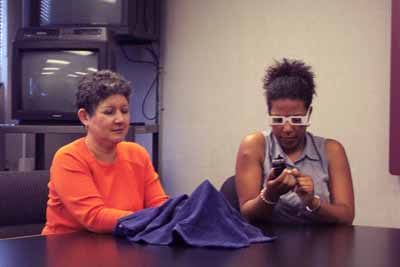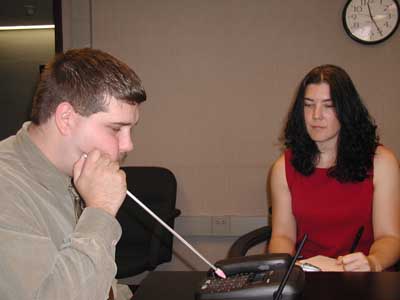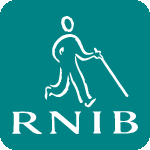Accessibility in User-Centered Design: Screening Techniques
Evaluating for Accessibility provides guidance on incorporating accessibility into common evaluation methods, and introduces screening techniques. This section discusses the following aspects of screening techniques:
- What Are Screening Techniques?
- Why Use Screening Techniques?
- Using Screening Techniques
- Screening Technique Descriptions
What Are Screening Techniques?
Screening techniques are simple activities to help identify potential accessibility barriers in product designs. Most screening techniques involve interacting with a product with one or more physical or sensory abilities eliminated or modified; for example, wearing thick gloves to limit your dexterity, and wearing low vision glasses or blindfolds to limit your vision.

Screening techniques involve using adaptive strategies, assistive devices, and assistive technologies. For example, a software designer turns off her monitor and uses a screen reader to interact with her application; a usability specialist uses a mouthstick or unplugs his mouse to get an idea of how usable a product is by people who cannot use their arms or hands.

Screening techniques are most effectively used early in design and evaluation, along with the other methods described throughout the book.
Screening techniques are not simulations
Screening techniques are not disability simulations. The term "simulation" implies accurately re-creating a situation or circumstance, and these screening techniques do not replicate the real-life experiences of people with disabilities. People with disabilities are likely to do much better using a product than people who are using screening techniques, because they are used to interacting with products with their functional limitation.
One of the reasons it's important to understand that screening techniques are not simulations is because they can produce incomplete or inaccurate results. For example, screen readers have a fairly high learning curve and most designers using them for screening don't know many of their features. When a designer finds a problem, he could attribute it to the product being evaluated, when in fact the problem is in his lack of skill using the screen reader.
Why Use Screening Techniques?
Screening techniques are easy, quick, and inexpensive. Designers and evaluators use screening techniques throughout the design process with various types of evaluations. Screening techniques identify potential design problems early, to help avoid significant redesign costs and delays late in the process.
Screening techniques can make later usability testing with real participants with disabilities more efficient by identifying obvious problems before formal testing. Using screening techniques and conducting a pilot test help avoid the pitfall of bringing in people with disabilities only to discover the product is so inaccessible that you cannot complete the usability test. Eliminating major problems identified through screening techniques allows usability testing to focus on more subtle issues and problem areas.
One of the challenges in evaluating for accessibility is to determine which functional limitations to include, as addressed in "Determining Participant Characteristics" in the Planning Usability Testing section. Screening techniques are a way to evaluate more functional limitations because they are generally inexpensive and simple, whereas formal usability testing with people with disabilities is more costly. In one study, product evaluations conducted by participants who were blind and by sighted participants who were blindfolded yielded similar results. [1] However, in many cases screening techniques cannot produce similar results, especially when assistive technologies are involved. It is best to combine using screening techniques with using real people with disabilities in evaluation.
While this section primarily discusses using screening techniques in accessibility evaluation, the techniques are also valuable tools for training and awareness. Product designers who interact with products using accessibility screening techniques will better understand designing for accessibility.
Using Screening Techniques
Apply screening techniques throughout the design process with different types of evaluations, such as:
- Designers use screening techniques very early in the design process to evaluate example products and get an idea of the potential accessibility issues related to their product.
- Accessibility evaluators use screening techniques themselves to help with their heuristic evaluations and design walkthroughs.
- Accessibility evaluators conduct informal usability tests with participants using screening techniques. The next section addresses planning, preparing for, and conducting usability tests.
Use extra precautions when using screening techniques that change a person's physical or sensory capabilities. For example, a person wearing a blindfold might have poor balance, and a person whose hearing is blocked will not hear auditory warnings.
"Becoming Familiar with the Assistive Technology" in the Preparing for Usability Testing section includes general suggestions for using assistive technology.
Screening Technique Descriptions
The following papers and resources describe some specific accessibility screening techniques:
- Law, C. M, & Vanderheiden, (1999). Tests for screening product designs prior to user testing by people with functional limitations. HFES'99 (Human Factors & Ergonomics Society annual meeting)
- Law, C., Barnicle, K., and Henry, S.L. Usability screening techniques: evaluating for a wider range of environments, circumstances and abilities. Proceedings of UPA 2000 (Usability Professionals' Association annual conference), 2000.
- Preliminary Review of Web Sites for Accessibility from the World Wide Web Consortium (W3C) Web Accessibility Initiative (WAI)
- The Trace R&D Center offers a kit that provides materials for screening techniques with products, along with an instruction guide.
References
- Law, C. and Vanderheiden, G.C. Reducing Sample Sizes When User Testing with People who Have, and who are Simulating Disabilities — Experiences with Blindness and Public Information Kiosks. Proceedings of the XIVth Triennial Congress of the International Ergonomics Association and 44th Annual Meeting of the Human Factors and Ergonomics Society, 2000.
Some of the information in this chapter was previously published in:
- Henry, S.L., Law, C., and Barnicle, K. Adapting the Design Process to Address More Customers in More Situations. Proceedings of UPA 2001 (Usability Professionals' Association annual conference), 2001.
- Law, C., Barnicle, K., and Henry, S.L. Usability screening techniques: evaluating for a wider range of environments, circumstances and abilities. Proceedings of UPA 2000 (Usability Professionals' Association annual conference), 2000.
 You can get the Just Ask book from www.uiAccess.com/accessucd/print.html
You can get the Just Ask book from www.uiAccess.com/accessucd/print.html

